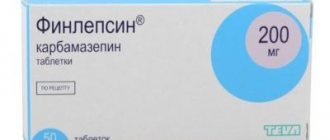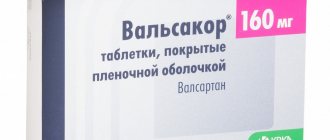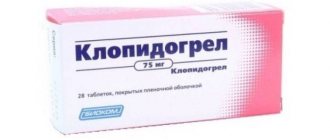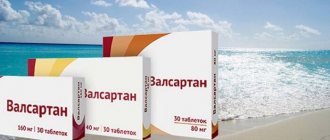Pharmacodynamics and pharmacokinetics
Sumatriptan constricts cerebral blood vessels by interacting with 5-HT1 receptors in the brain. It is noteworthy that the substance does not affect 5-HT2 - 5-HT7 receptors . Serotonin 5-HT1D receptors are also involved in the mechanism of action of the drug, however, in a selective manner. Due to this, the trigeminal system is not activated, and the specific stimulating protein in the nuclei of the trigeminal nerve . The vessels that were dilated during a migraine attack narrow, and the attack stops. The product does not have a direct analgesic effect.
When taken orally or intranasally , the active component of the drug is quickly absorbed into the systemic circulation. Its bioavailability is only 15%. After 2.5 hours, the drug reaches its maximum concentration of 51 ng per 1 ml. When administered intranasally , this occurs after 1.5 hours.
MAO takes part in its biotransformations in the body . The main metabolite of sumatriptan is its glucuronide . The drug is excreted by the kidneys and through the gastrointestinal tract .
Improvements in the patient's condition begin to occur half an hour after taking 100 mg of the drug and 15 minutes after intranasal administration.
Within 24 hours after an attack and taking the drug, relapses may occur; therefore, the drug is reused.
Release form and composition
The drug is produced in the form of film-coated tablets, white in blister packs.
The active substance in the composition is sumatriptan, which affects the smooth muscles of the blood vessels of the brain, promotes vasoconstriction of the carotid arteries and suppresses the activity of the trigeminal nerve.
The excipients in the composition of the drug are the following components:
- Microcrystalline cellulose;
- Potato starch;
- Lactose;
- Magnesium stearate;
- Sodium carboxymethyl starch.
Contraindications
The medicine is contraindicated:
- pregnant and lactating women;
- for hemiplegic migraine ;
- ophthalmoplegic migraine;
- basilar migraine;
- for stroke or other cerebral circulatory disorders;
- with ischemia ;
- teenagers and older people;
- for serious liver diseases;
- for epilepsy ;
- allergies to the components of the product;
- for transient ischemic attacks ;
- when taking drugs that are not compatible with Amigrenin, for example MAO inhibitors , ergotamine (see drug interactions).
pharmachologic effect
Antimigraine drug. A specific selective agonist of serotonin 5HT1B-1D receptors (5-hydroxytryptamine-1-like), located predominantly in the smooth muscles of the walls of blood vessels in the brain. Stimulation of 5HT1 receptors leads to selective vasoconstriction in the carotid artery system and a decrease in neurogenic inflammation, without significantly affecting cerebral blood flow. In addition, it has been experimentally established that sumatriptan inhibits the activity of the trigeminal nerve.
It is believed that these effects help reduce the severity of migraine pain.
The clinical effect is observed 30 minutes after oral administration of the drug.
Side effects
Side effects from the cardiovascular system : decreased blood pressure, tachycardia and angina pectoris , palpitations, increased blood pressure , bradycardia , ischemia . Raynaud's syndrome is very rare .
Possible allergies ( hives , skin rashes or itching).
Side effects from the gastrointestinal : vomiting, indigestion, pain in the stomach, nausea. ischemic colitis or increased levels of hepatic transmyases occur .
From the nervous system may occur: weakness, drowsiness, blurred vision, apathy.
Also observed: sensations of warmth, compression, tingling or heaviness, muscle pain.
Side effects
The use of Amigrenin in some cases can cause the following side effects:
- Decrease or increase in pressure;
- Tachycardia;
- Bradycardia;
- Nausea;
- Vomit;
- Weakness;
- Dizziness;
- Severe heart rhythm disturbances;
- Epileptic seizures;
- Discomfort in the epigastrium;
- Ischemic colitis;
- Dysphagia;
- Increased activity of liver enzymes;
- Raynaud's syndrome;
- Fatigue and drowsiness;
- Partial visual impairment;
- Diplopia and nystagmus (rare);
- Allergic reactions (itching, rash, anaphylactic reactions, myalgia).
Instructions for Amigrenin (method and dosage)
The medicine can only be used for sudden migraine , as an emergency remedy.
Instructions for use of Amigrenin : The drug is prescribed to adults. The maximum amount per day is 300 mg. As a rule, 50 or 100 mg are prescribed at a time.
If after some time the symptoms resume, then the next dose can be taken no earlier than 2 hours, but no later than 24 hours after the initial one.
If the drug does not provide relief, you should consult your doctor and take another medicine.
Pharmacological properties
Pharmacodynamics
Sumatriptan, the active ingredient in Amigraine, is an anti-migraine drug. It belongs to the specific and selective agonists of 5-HT1-serotonin receptors, located mainly in the blood vessels of the brain. The effect of sumatriptan does not apply to other types of 5-HT-serotonin receptors (5-HT2-7). The compound promotes constriction of the vessels of the carotid arterial bed, supplying blood to intracranial and extracranial tissues (the mechanism for the development of migraine in humans is edema and/or dilation of the vessels of the meninges). In this case, the drug has virtually no effect on cerebral blood flow.
Sumatriptan inhibits the activity of receptors localized in the endings of the afferent fibers of the trigeminal nerve in the dura mater (as a result, the excretion of sensory neuropeptides decreases). Amigrenin helps get rid of photophobia and nausea that accompany a migraine attack. When taken orally at a dose of 25–100 mg, in 50–70% of cases the drug quickly stops such an attack. Within 24 hours, one third of cases experience a relapse, requiring re-administration of sumatriptan. After taking the drug orally at a dose of 100 mg, it begins to act within 30 minutes.
Pharmacokinetics
When taken orally, sumatriptan is absorbed at a high rate. After 45 minutes, 70% of the maximum content of the substance in plasma is reached. When administered orally at a dose of 100 mg, the maximum plasma level of sumatriptan is approximately 54 ng/ml. Bioavailability does not exceed 14% due to incomplete absorption and first-pass metabolism.
Sumatriptan is bound to plasma proteins by 14–21% and is metabolized through oxidation, in which monoamine oxidase takes part. As a result, several metabolites are formed, the main of which is the indoleacetic analogue of sumatriptan, which does not exhibit pharmacological activity against 5-HT1 and 5-HT2 serotonin receptors.
The half-life of sumatriptan is 2 hours. The main metabolite of the drug, an indoleacetic analogue of its active component, is excreted in the urine in the form of free acid and its glucuronide conjugate. It is assumed that migraine attacks do not have a significant effect on the pharmacokinetics of sumatriptan when administered orally.
Interaction
The drug pharmacologically incompatible with MAO inhibitors .
Combining the drug with ergotamine can lead to prolonged vasospasm.
The simultaneous use of antidepressants and Amigrenin increases the risk of hyperreflexia , impaired coordination of movements and asthenia .
The medicine increases the toxicity of furazolidone and lithium preparations .
It is highly not recommended to combine the drug with selegiline .
special instructions
Particular caution should be exercised when prescribing the drug to epileptics , with controlled arterial hypertension or people with reduced seizure activity.
To avoid spasm of the coronary arteries in patients with diseases of the cardiovascular system, the first dose of the drug should be taken under the supervision of a physician.
If you are hypersensitive to sulfonamides , severe allergic reactions are possible. It is not recommended to prescribe the medicine.
No pharmacokinetic features were identified in patients over 65 years of age.
Due to the high risk of developing drowsiness when taking the drug, it is recommended to refrain from driving or performing activities that require great concentration and reaction speed.
Analogues of Amigrenin
Level 4 ATC code matches:
Zolmitriptan
Rapidmed
Imigran
Zomig
Relpax
Sumamigren
Sumatriptan
The closest analogues: Sumitran, Imigran, Rapided, Sumamik, Sumatriptan, Sumig, Trimigren, Migrepam, Sumamigren, Sumarin, Zomig .
Amigrenin price
The price of Amigrenin is approximately 155 rubles for 2 tablets of 50 mg.
- Online pharmacies in RussiaRussia
ZdravCity
- Amigrenin tablets p.p.o.
50 mg 6 pcs. JSC Veropharm 431 rub. order - Amigrenin tablets p.p.o. 100 mg 6 pcs. JSC Veropharm
RUB 755 order
- Amigrenin tablets p.p.o. 100 mg 2 pcs. JSC Veropharm
RUB 342 order
- Amigrenin tablets p.p.o. 50 mg 2 pcs. JSC Veropharm
RUB 281 order
Dosage regimen
Amigrenin is not intended for use for prophylactic purposes.
For adults
prescribed in a single dose of 50 mg, in some cases - 100 mg. The maximum daily dose is 300 mg.
If migraine symptoms do not disappear or decrease after taking the first dose of Amigrenin , then the drug should not be re-prescribed to relieve an ongoing attack. If symptoms have decreased or gone away and then returned, you can take a second dose within the next 24 hours. The interval between doses of the drug should be at least 2 hours.






